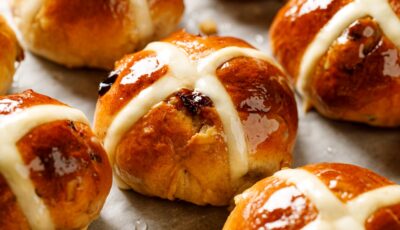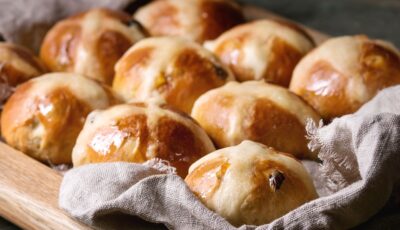Hot cross bun is a type of sweet bread eaten at Easter in Ireland. Although it’s a British specialty, this bread roll is just as popular on the Emerald Isle, and consumed en masse at the festival. Delicious, it’s usually made with spices (nutmeg and cinnamon), raisins and orange zest. It’s easily recognized by the powdered sugar cross that decorates the top of the loaf.

Hot Cross Buns – © zi3000
Hot cross bun is undoubtedly THE speciality to enjoy in Ireland at Easter. Traditionally, this bread is baked and eaten on Good Friday to break the fast. It’s a real delight, and a real treat after hours of deprivation!
Special fact: this type of bread has the advantage of not rotting. As soon as it was created, it was dried and stored for several months. A big advantage!
Historically speaking, the hot cross bun is thought to have pagan origins, before becoming a Christian specialty. The first mentions of this specialty date back to the 12th century, when an English monk is said to have marked bread rolls with the sign of the cross in honor of Good Friday.
A story from the 14th century describes how a monk from St. Martin’s, in the south of France, was forced to leave the monastery. On Good Friday, St. Albans distributed spiced cakes to the needy, inaugurating an annual tradition.
During the reign ofElizabeth I, when Roman Catholicism was outlawed, making the sign of the cross on bread rolls was considered papism and the practice was banned. But neither Church nor State could suppress the popular custom, so a law was enacted to limit the consumption of Hot Cross Buns to legitimate religious occasions such as Christmas, Easter and funerals.
Nowadays, the Hot Cross Bun is an Easter staple. It’s during this period that many Irish bakeries and households prepare these brioche buns. You’ll find them everywhere: in supermarkets, bakeries, tea rooms and Irish families.

Irish hot cross buns – © natashabreen
The Irish live in permanent superstition! And they have a lot of beliefs about these hot rolls! Even today, the way they are shaped and baked is of great importance!
Here, then, is a brief overview of the various beliefs associated with this Anglo-Saxon pastry.
If Hot Cross Buns are baked on Good Friday and kept until the following year, they are said to have the power to protect a house from fire. A way to protect your home from accidents!
Similarly, buns were also taken aboard boats for superstitious reasons: they were said to protect against storms and shipwrecks!
In the Middle Ages, there was a popular belief that people should hang Hot Cross Buns from the rafters of their homes. Once hung, they would then have the ability to protect the house’s inhabitants from disease for the coming year.
What’s more, in the event of illness, these buns were dried, then ground to a powder and mixed with water. This mixture was then served to the sick to cure them.
If you’re a sweet tooth with a sweet tooth, then Hot Cross Bun is a must-try! Its taste can be compared to that of a traditional French sugar loaf.
There are also variations with blueberries: a real treat for fruit lovers!
Thin and soft, they are a real invitation to indulge and are usually eaten cut in half, with butter spread on top. It goes well with a good cup of Irish tea, at snack time or for breakfast.
They’re easy to find just about anywhere, and cost less than €2 a piece!
15 brioches